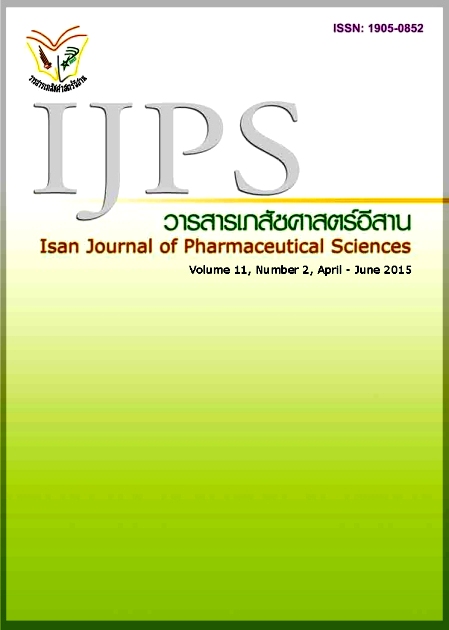Monitoring the achieving therapeutic target in warfarin-administered patients by International normalized ratio at Prasat Neurological Institute
Main Article Content
Abstract
Warfarin is the drug that can monitor its effi cacy and safety of treatment by the usage of International normalized ratio (INR) value. The objective of this study is to determine the percentage of achieving therapeutic target INR in warfarin-administered patients at Prasat Neurological Institute. Methods: This study was retrospective-descriptive study design and data were collected from medical records of the patients receiving warfarin in outpatient department at Prasat neurological institute for 3 years (July 2009 - July 2012). Results: Three hundred eigthty nine patients were included into the study, average age was 63.04 years old. Most patients receiving warfarin for preventing embolism in patients with atrial fi brillation (36.76%). The average duration of INR monitoring was 1.05 years and the frequency of INR monitoring was 10.12 times per year. The percentage of achieving therapeutic target INR was only 37.28%. This study found that 47.08% was below and 15.64% was exceed the therapeutic target INR. Proportion of low variability of INR values was 8.74%. The most prescribed medications that had were potential drug interactions with warfarin was anti-dyslipidemia medications. Twenty-six events of warfarin adverse drug reactions were found including: 1.95 time/100 person-year of major bleeding and 4.39 time/100 person-year of minor bleeding. Conclusion: The results of this study can be used as a base line to organize the warfarin clinic at Prasat Neurological Institute.
Article Details
In the case that some parts are used by others The author must Confirm that obtaining permission to use some of the original authors. And must attach evidence That the permission has been included
References
Aguilar MI, Hart R. Oral anticoagulants for preventing stroke in patients with non-valvular atrial fibrillation and no previous history of stroke or transient ischemic attacks. Cochrane Database Syst Rev. 2005 Jul 20;(3):CD001927.
Akhtar RP, Abid AR, Zafar H. Anticoagulant in patients following prosthetic heart valve replacement. Ann Thorac Cardiovasc Surg 2009;15:10–17.
American College of Chest Physicians. The Sixth ACCP Consensus Conference on antithrombotic therapy .Chest 2001. Jan;119/1(Suppl.)/January 2001.
Baker W, Cios DA, Sander SD, et al. Meta-analysis to assess the quality of warfarin controlin atrial fi brillation patients in the United States. J Manage Care Pharm 2009. Apr;15 (3): 244–252.
British Columbia Medical Association. Guidelines & protocols advisory committee warfarin therapy management. 2010 Oct [cited 2014 Sep 7]. Available from:http://www.bcguidelines.ca/guideline_warfarin_management.html
Choicharnchaikul S. and Malathum P. The use of warfarin in older adults: a case study and caring. Rama Nurs J 2008; 14: 366-384.
Hirsh J, Fuster V, Ansell J, et al. American Heart Association/American College of Cardiology Foundation guide to warfarin therapy. Circulation 2003;(107):1692-1711.
Lertsinudom S, Chumworathayi P. Chaiyakum A. Drug use review of warfarin in medicine ward, Srinagarind Hospital. SMJ 2010; (25): 6-13.
Liabthawee W. Impact of education and counseling by clinical pharmacists on anticoagulation therapy in patients with mechanical valve. Faculty of Graduate Studies Mahidol University 2004;20– 21.
Nathisuwan S. Pharmacology of warfarin and heparins. The Conference of Intensive Anticoagulation Training Program. 20-21 DEC 2007. BKK. (Thai)
Reynolds MW, Fahrbach K, Hauch O, et al. Warfarin anticoagulation and outcomes in patients with atrial fibrillation:a systematic review and metanalysis Chest 2004; (126):1938–1945.
Sittidach M. et al. Effect of pharmaceutical care on patients with mechanical prosthetic valve who received warfarin at Songklanagarind hospital. Songkla Med J 2012;2(30):63-73.
Sribunsi P, Kamikael P, editors. Handbook of warfarin for pharmacist; experience from Central Chest Institute of Thailand. Department of Medical Services 2010. (Thai)
Tepsanongsuk T, Dilokpattanamongkol P. A special project ; Evaluation of quality in the control of International Normalized Ratio (INR) among patients receiving warfarin therapy. Faculty of Pharmacy Mahidol University 2007. (Thai)
The Heart Association of Thailand under the Royal patronage of H.M. the King. Warfarin guideline. 1st ed. BKK : National Security Health Offi ce ; 2010. (Thai)
The University of Wisconsin School of Medicine and Public Health. Warfarin management adult ambulatory: primary and specialty care clinical practice guideline. [cited 2012 Sep 28]. Available from: URL: http://www.uwhealth.org/search/Search.action?collection=uwhealth-org&q=warfarin&sa=.
Vattanasombat S. Anticoagulant:warfarin continue education (online).TBPS 2010;July:1-10. (Thai)
Yasaka M, Minematsu K, Yamaguchi T. Optimal intensity of international normalized ratio in warfarin therapy for secondary prevention of stroke in patients with non-valvular atrial fi brillation. Intern Med 2001; 40:1183–1188.


